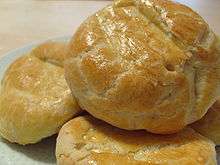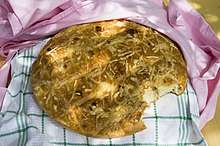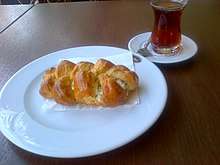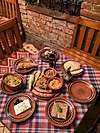Pogača
Pogača (Croatian and Bosnian), poğaça (Turkish), pogácsa (Hungarian), pogace (Romanian), (Greek: μπουγάτσα 'bughátsa', Macedonian, Serbian and Bulgarian: погача, Albanian: pogaçe) is a type of bread baked in the ashes of the fireplace, and later on in the oven, similar to focaccia, with which it shares the name (via Byzantine Greek: πογάτσα), found in the cuisines of the Carpathian Basin, the Balkans, and Turkey. It can be leavened or unleavened, but only experienced cooks can make good-quality unleavened pogača, while the pastry with yeast is easier to make. It is generally made from wheat flour, but barley and sometimes rye may be added. It can be stuffed with potatoes, ground beef, or cheese, and have grains and herbs like sesame, black nigella seed, or dried dill in the dough or sprinkled on top.
 Pogača stuffed with lor cheese and dill | |
| Alternative names | Pogacha |
|---|---|
| Type | Bread |
| Place of origin | Balkans, Turkey, Carpathian Basin |
| Main ingredients | White flour or whole-wheat flour, usually yeast, Egg, Butter |
| Variations | Karaköy |
| 196kcal per 45 gr [1] kcal | |
Terminology

The word derives ultimately from the Latin panis focacius, i.e. bread (panis) baked on the hearth or fireplace (focus), via the Byzantine Greek πογάτσα (pogátsa), and, more recently, south Slavic languages (cf. pogača / погача).
A variant is known as pogačice (diminutive form), a type of puff pastry eaten in Bosnia and Herzegovina, Bulgaria, Croatia, Kosovo, Montenegro, Macedonia, Serbia, Slovenia, and Turkey (where it is called poğaça) with variations like karaköy and kumru. It is called pogatschen in Austria, and pagáče in Slovakia.

Slovenian pogača is a regional dish from White Carniola and Prlekija that is known locally under various names such as belokranjska pogača, ocvirkovca, gerpa, oprešak and postržjača. Rather than a stuffed savoury pastry, this dish is a type of traditional flatbread that is typically topped with ocvirki.
The pastry

Every place makes its own version, or more than one variety, and so they come in all different textures and flavors. Some pogača are only one inch around and one inch high; others are much larger. Some have a crumbly scone-like consistency inside, while others are more tender like a fresh dinner roll or croissant.
Many different ingredients can be used either in the dough, sprinkled on top before baking, or both: medium-firm fresh cheeses, aged dry hard cheese(s), pork crackling (tepertő), cabbage, black pepper, hot or sweet paprika, garlic, red onion, caraway seeds, sesame seeds, sunflower seeds or poppy seeds.
Pogača is sometimes served hot as an appetizer and/or bread. Hot pogača filled with sour cream (or curd and feta cheese in Turkey and Bulgaria) is considered a particularly delicious specialty.
References
- "Poğaça". Retrieved 3 January 2016.
External links
| Wikimedia Commons has media related to Poğaça. |

